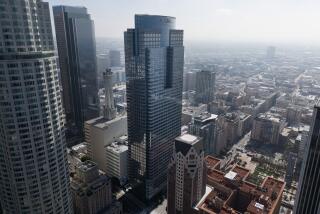Did ‘fracking’ play role in L.A. earthquake? Councilmen want to know

- Share via
Three Los Angeles City Council members want city, state and federal groups to look into whether hydraulic fracturing and other forms of oil and gas “well stimulation” played any role in the earthquake that rattled the city early Monday morning.
The motion, presented Tuesday by Councilmen Paul Koretz and Mike Bonin and seconded by Councilman Bernard Parks, asks for city departments to team up with the California Division of Oil, Gas and Geothermal Resources, the U.S. Geological Survey and the South Coast Air Quality Management District to report back on the likelihood that such activities contributed to the 4.4-magnitude quake.
Earlier this year, the council voted to draft rules that would bar hydraulic fracturing, often referred to as “fracking,” acidizing and other kinds of well stimulation in Los Angeles until council members felt sure that Angelenos and the water they drink were safe from their effects. The risk of triggering earthquakes was among the dangers cited by Bonin and Koretz, who championed the move.
“All high-pressure fracking and injection creates ‘seismic events,’” the motion states. It added, “Active oil extraction activities are reportedly taking place on the Veteran’s Administration grounds in West Los Angeles, nearby the epicenter” of the Monday quake.
“It is crucial to the health and safety of the City’s residents to understand the seismic impacts of oil and gas extraction activities in the City,” the motion said.
Environmental activists have pointed to swarms of earthquakes in Oklahoma, Arkansas and Ohio as evidence of the risk. Oil and gas companies counter that fracking and other technologies used to coax oil and gas from wells are safe, and have opposed the push to ban the methods inside L.A. city limits.
“I think people are trying to take advantage of a naturally occurring incident in order to attack our industry,” California Independent Petroleum Assn. CEO Rock Zierman said Tuesday. He said it had been proven that “there’s no link between operations and seismic activity.”
Seismologist Lucy Jones, a USGS science advisor for risk reduction, said she would need to know much more about nearby pumping in the area, such as whether someone was changing the water pressure deep in the ground, to say whether it could have been a factor in the Monday temblor.
However, “my first impression is that sounds implausible,” Jones said, “just because the earthquake was so deep. Induced earthquakes are almost always shallower than this.”
Monday’s quake struck in Encino on the northern edge of the Santa Monica Mountains in an area that has not seen much recent seismological activity.
The proposal will go to a council committee that handles public safety issues.
Twitter: @latimesemily
More to Read
Sign up for Essential California
The most important California stories and recommendations in your inbox every morning.
You may occasionally receive promotional content from the Los Angeles Times.











